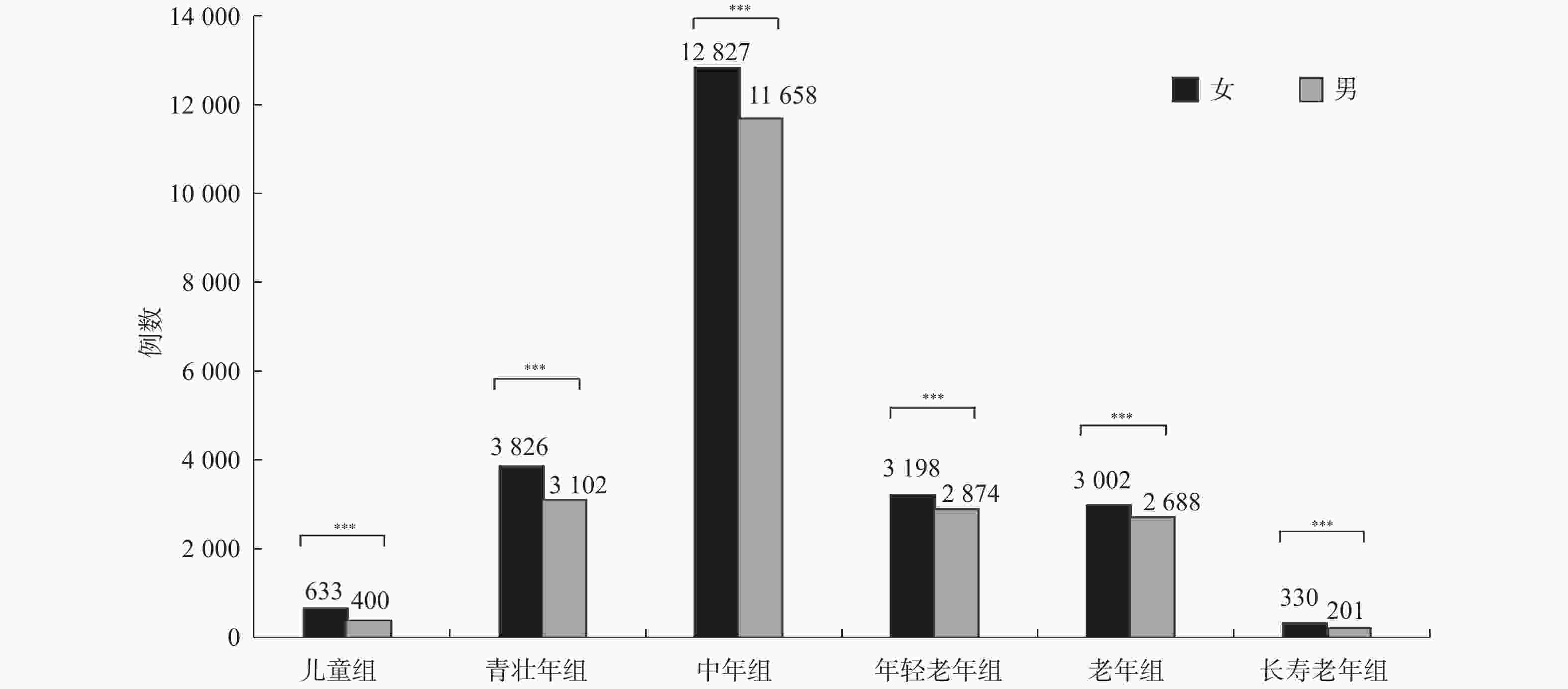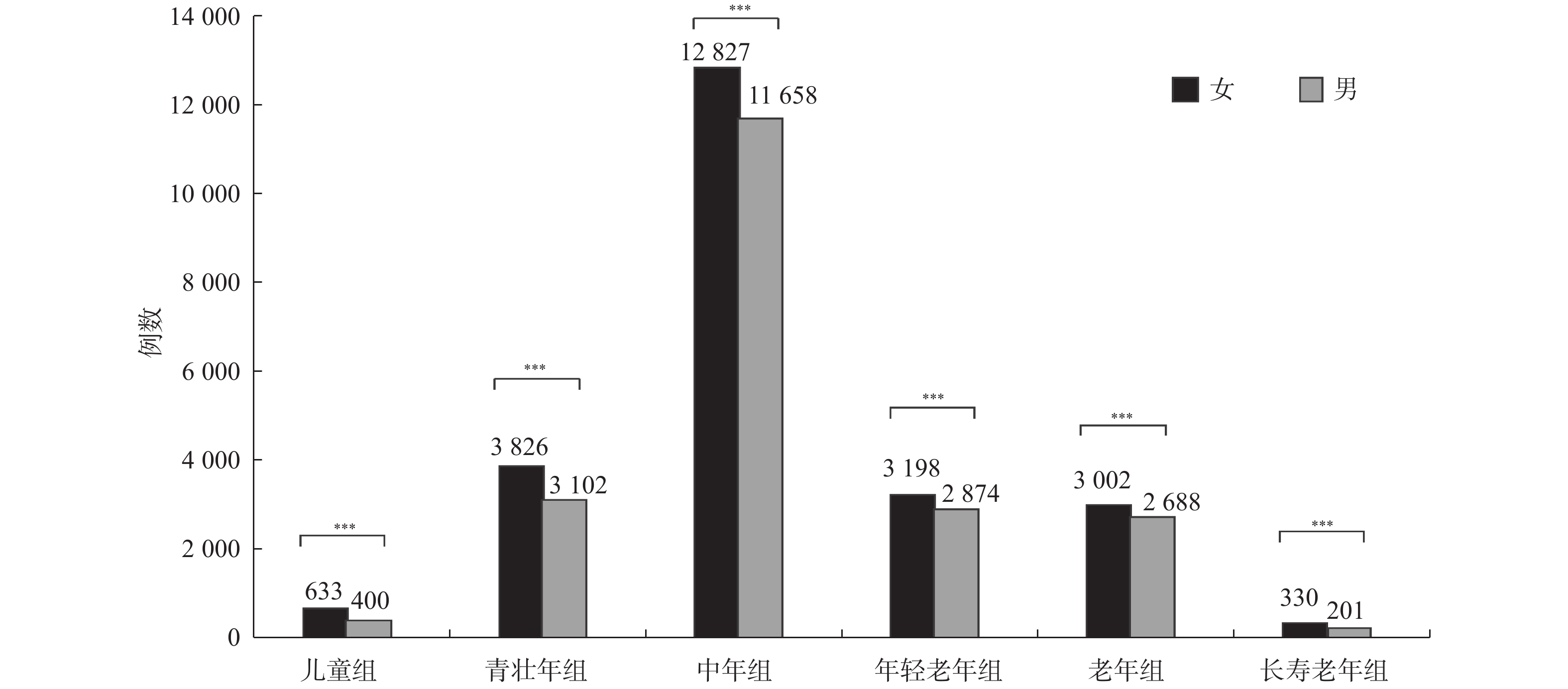Epidemiological Characteristics Among Emergency Triage Patients in a Comprehensive Tertiary Hospital in Kunming in 2020
-
摘要:
目的 研究云南省第一人民医院2020年新冠肺炎(COVID-19)疫情下急诊分诊患者流行病学特征,为进一步优化COVID-19疫情形势下急诊科的诊疗服务、应对措施及管理策略提供参考依据。 方法 回顾性收集2020年1月1日至12月31日至云南省第一人民医院就诊的44 739例急诊患者预检分诊记录,并建立数据库,分析就诊患者的性别、年龄、就诊时间、就诊季节、病情分级、来院方式等流行病学特征。 结果 44 739例急诊患者中,男性20 923例(47%),女性23 816(53%),年龄分布在0.2~110岁,以45~59岁年龄组为主,为25 828例(58%)。夏季最多12 449例(28%),秋季次之,11 558例(26%);每日就诊高峰时间主要为上午9:00~12:00和下午15:00~21:00;77%的患者打车和步行前来,12%的患者乘坐救护车;患者的病情分级比例为Ⅰ级(12%)、Ⅱ级(10%)、Ⅲ级(58%)、Ⅳ级(21%)。 结论 昆明市某综合性三甲医院急诊患者女性多于男性,年龄主要集中在45~59岁,夏季是就诊高峰季节,每日就诊高峰主要集中在上午9:00~12:00和下午15:00~21:00。急诊科应结合当前COVID-19疫情的防控要求,合理地配置急诊医疗资源。 Abstract:Objective To study the epidemiological characteristics of patients triaged in the emergency department during COVID-19 pandemic in our hospital in 2020 to provide a reference basis for further optimizing the diagnosis and treatment services, response measures, and management strategies in the emergency department. Methods The triage registration records of 44, 739 emergency patients who visited the First People’s Hospital of Yunnan Province from January 1 to December 31, 2020, were retrospectively collected, and a database was established. Epidemiological characteristics were analyzed based on age, sex, visiting season, disease grading, and way of visiting the hospital. Results Among the 44, 739 emergency patients, 20, 923 (47%) were male and 23, 816 (53%) were female. The age ranged from 0.2 to 110 years old, with 25, 828 cases (58%) mainly among 45 to 59 years old. The maximum number of patients visited in summer was 12, 449 (28%), followed by 11, 558 (26%) in autumn; the peak hours of visits were mainly from 9:00 am to 12:00 am and from 3:00 to 9:00 pm; 77% of the patients came to the clinic by taxi and by foot, and 12% by ambulance; The proportion of patients with disease grading was grade I (12%), grade II (10%), grade III (58%), and grade IV (21%). Conclusion A comprehensive tertiary hospital in Kunming has more female than male emergency patients, and their ages are mainly between 45 and 59 years old; the summer is the peak season for consultation, and the daily consultation peaks are mainly on 9:00-12:00 a.m and 15:00-21:00 p.m.The emergency department should combine the current COVID-19 epidemic control requirements with reasonable allocation of emergency medical resources. -
Key words:
- Emergency /
- Epidemiology /
- Triage /
- COVID-19
-
表 1 急诊患者基线特征[n(%)]
Table 1. Baseline characteristics of emergency patients [n(%)]
指标 n(%) 性别 男性 20 923(47) 女性 23 816(53) 男女比例 20 923∶23 816(1∶1.14) 年龄组 儿童组 1 033(2) 青壮年组 6 928(15) 中年组 25 828(58) 年轻老年组 6 072(14) 老年组 4 347(10) 长寿老年组 531(1) 表 2 不同季节的患者分布特征[n(%)]
Table 2. Seasonal distribution characteristics of emergency patients [n(%)]
季节 n(%) 春季 9 819(22.0) 夏季 12 449(28.0) 秋季 11 558(26.0) 冬季 10 913(24.0) 表 3 不同时段的患者分布特征[n(%)]
Table 3. Characteristics of the distribution of emergency patients in different time periods [n(%)]
时段 n (%) 00:00~03:00 3 823(9.0) 03:00~06:00 2 336(5.0) 06:00~09:00 3 217(7.0) 09:00~12:00 7 876(18.0) 12:00~15:00 6 360(14.0) 15:00~18:00 7 470(17.0) 18:00~21:00 7 326(16.0) 21:00~24:00 6 331(14.0) 表 4 急诊患者病情分级特征[n(%)]
Table 4. The triage situation of emergency patients [n(%)]
病情分级 n(%) Ⅰ级 5 162(12.0) Ⅱ级 4 275(10.0) Ⅲ级 23 801(58.0) Ⅳ级 9 501(20.0) -
[1] 张杰,孙卉,木丽华,等. 昆明市院前急救患者流行病学的调查[J]. 昆明医科大学学报,2022,43(3):108-112. [2] 急诊预检分诊专家共识组. 急诊预检分诊专家共识[J]. 中华急诊医学杂志,2018,27(6):599-604. doi: 10.3760/cma.j.issn.1671-0282.2018.06.006 [3] 吕佩源,高文娟,何其慧. 新型冠状病毒感染常态化疫情防控形势下综合医院预检分诊工作拓展与完善[J]. 中国临床医生杂志,2021,49(1):1-2. doi: 10.3969/j.issn.2095-8552.2021.01.001 [4] Leszczy ń ski P K,Sobolewska P,Muraczyńska B,et al. Impact of COVID-19 pandemic on quality of health services provided by emergency medical services and emergency departments in the opinion of patients:Pilot study[J]. Int J Environ Res Public Health,2022,19(3):1232-1242. doi: 10.3390/ijerph19031232 [5] 张少辉,孙文文,郏建臣. 某三甲医院2019年20246例急诊患者流行病学特征分析[J]. 现代医药卫生,2021,37(20):3534-3537. doi: 10.3969/j.issn.1009-5519.2021.20.030 [6] 宋昆,林航,丁宁,等. 某综合三甲医院急诊抢救室患者流行病学调查及分析[J]. 中国急救复苏与灾害医学杂志,2020,15(5):598-600,628. doi: 10.3969/j.issn.1673-6966.2020.05.027 [7] Hofman M,Van den Hanenberg F,Sierevelt I,et al. Elderly patients with an atypical presentation of illness in the emergency department[J]. The Netherlands Journal of Medicine,2017,75(6):241-246. [8] 中华医学会急诊医学分会,中国医师协会急诊医师分会,解放军急救医学专业委员会,等. 新型冠状病毒感染疫情常态化防控形势下急危重症患者急诊预检分诊与救治专家共识[J]. 中华急诊医学杂志,2022,31(3):297-302. doi: 10.3760/cma.j.issn.1671-0282.2022.03.006 [9] Kim S,Kang H,Cho Y,et al. Emergency department utilization and risk factors for mortality in older patients:An analysis of Korean national emergency department information system data[J]. Clin Exp Emerg Med,2021,8(2):128-136. doi: 10.15441/ceem.20.098 [10] McKenna P,Heslin S M,Viccellio P,et al. Emergency department and hospital crowding:Causes,consequences,and cures[J]. Clin Exp Emerg Med,2019,6(3):189-195. doi: 10.15441/ceem.18.022 [11] Rasouli H R,Aliakbar Esfahani A,Abbasi Farajzadeh M. Challenges,consequences,and lessons for way-outs to emergencies at hospitals:A systematic review s tudy[J]. BMC Emerg Med,2019,19(1):62. doi: 10.1186/s12873-019-0275-9 [12] 王蕊. 我国综合性医院急诊科拥挤现象及对策研究进展[J]. 循证护理,2019,5(4):314-317. doi: 10.12102/j.issn.2095-8668.2019.04.005 [13] Pan W,Zhang K,Li H,et al. Older adults are prioritized in terms of waiting time under the emergency triage system in Guangzhou,China[J]. Geriatr Gerontol Int,2019,19(8):786-791. doi: 10.1111/ggi.13714 [14] Natafgi N,Mohr N M,Wittrock A,et al. The association between telemedicine and emergency department (ED) disposition:A stepped wedge design of an ED-based telemedicine program in critical access hospitals[J]. J Rural Health,2020,36(3):360-370. doi: 10.1111/jrh.12370 [15] Joy T,Ramage L,Mitchinson S,et al. Community emergency medicine:Taking the ED to the patient:A 12-month observational analysis of activity and impact of a physician response unit[J]. Emerg Med J,2020,37(9):530-539. doi: 10.1136/emermed-2018-208394 [16] Xu N,Bai J,Yan R. Identifying the vulnerable regions of emergency medical services based on the three-stage of accessibility:A case study in Xi'an,China[J]. Int J Equity Health,2022,21(1):54. doi: 10.1186/s12939-022-01653-0 -






 下载:
下载:




